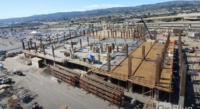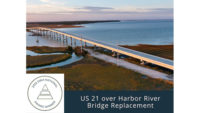Design-build has been a staple of transportation project delivery for years, but the approach is not always the optimum one, said attendees at one panel of the annual Transportation Research Board forum, which recently concluded in Washington, D.C.
Eric Kahlig, alternative project delivery administrator at the Ohio Dept. of Transportation, said the agency holds proprietary technical information meetings weeks before the bidding process with a shortlist of contractors "that has eliminated surprises over the years."
But he cited one unnamed project where design-build was chosen despite "red flags" that included having to work closely with railroads, unfavorable geotechnical conditions and political promises in "an election year" to use as many local and disadvantaged firms as possible. "It was the wrong project type," for design-build, he said, noting that the job came in 1.5 years late and $10 million over budget. "But it was successful politically."
Jay Hietpas, assistant commissioner of operations for the Minnesota Dept. of Transportation, added that a small design-build project in his state, about $1 million to replace signs, resulted in a claim as small contractors "weren't used to" the approach. "Indefinite delivery/quantity would have been better," he said.
"All design-builders are contractors, but not all contractors may be design-builders," said Shailendra Patel, alternative project delivery administrator for the Virginia Dept. of Transportation, which has used such alternate methods since 2004. "The project never fails—people fail."
He said the agency holds the design-build team responsible for both project quality assurance and quality control.
Right Time and Place
Addressing lessons learned, panelists said design-build can be a good tool—if used in the right time and place.
Panelists discussed at length the challenge of balancing technical, time, and pricing scores in choosing a best-value-based design-build team. Patel noted one example where the team with the lowest price took legal action after a $100-million bridge job went to the team with the higher technical score. The team argued that under the requirements, the right-of-way manager of the winning team did not have the requ9ired 10 years of experience.
"Understand and follow your own requirements," Patel said. VDOT cancelled the bid and reissued the RFP, but ended up with the same two finalists—despite the previous winning team lowering its bid by $10 million.
The DOT managers concurred that bidding is tough on contractors, for whom stipends are small comfort when losing the bid. "The industry has a right to protest" bid results, said Hietpas. After the bid process got underway to build a replacement for the collapsed I-35W bridge in Minneapolis in 2007, "we sat down with industry and asked, 'what are your concerns?' How can we get better as an agency? ... we developed the [construction manager-general contractor] process together."
Patel also cautioned about potential conflict of interests regarding consultants that may do bridging documents for DOTs while also being on competing alternative project delivery teams.
As progressive design-build continues to gain favor among owners as an alternative for tackling complex, multi-phase projects, members of another forum panel were divided on its merits and potential shortcomings.
Kiewit Development Co. Vice President Henry Patel credited its collaborative model for making “the best use of people we have on both sides” to address time and resource issues. Flatiron Construction Senior Vice President Ural Yal added that the method offers a more effective means to avoid disputes associated with subsurface conditions and stakeholder issues—“the two biggest reasons projects go bad.”
Former Maryland Transportation Secretary Pete Rahn took a more cautious view, however, asserting that progressive design-build eliminates the “tension of competition and innovation” in conventional design-build procurements that "drives value.” The industry veteran, who led two other state DOTs, said “That means a better project for the public.”
What’s more, Rahn added, owners tend to be at a disadvantage when it comes to negotiating project prices using progressive design-build.
“No DOT will have the information a contractor has, which is disadvantageous to the agency,” he said.
Session attendees suggested ways to enhance progressive design-build implementation, such as taking advantage of longer timelines to facilitate greater local contractor involvement, achieving owner “design-to-budget” goals and incentivizing project teams to develop alternative technical concepts that address risks before setting prices.
Speakers agreed that while progressive design-build is not a panacea to minimize risks of complex projects, it still can be useful to transportation agency project delivery under the right circumstances. it’s up to owners to identify each project’s needs and the best approach
to dealing with them, rather than “choosing the project delivery method
du jour,” said Thom Sherman, former director of Virginia DOT’s P3 office who now directs public sector initiatives and programming for the Association for Improvement of American Infrastructure.
High Tech Opportunities and Risks
Several forum sessions addressed artificial intelligence (AI), which many transportation agencies are exploring to improve operational efficiency and share information. A Massachusetts Dept. of Transportation AI-based system helps entry-level engineers more easily understand project documentation and best practices, reducing their reliance on more experienced personnel, while a Washington State DOT research collaboration has developed and installed a self-learning and optimizing system to help manage commercial truck parking at state highway rest areas.
While agencies are intrigued by AI’s potential benefits, they are equally wary of risks and vulnerabilities—such as deliberate manipulation, or “deep faking,” of images, absence of curated information and biases that may be introduced by bad actors.
Even quality of data provided by increasingly popular AI-driven chatbot software is a concern, with presenters noting differences in accuracy of information provided in the free and subscription versions of some products.
“You can’t trust everything that comes out of the models,” cautioned Jessie Newberry, MassDOT business engagement manager. “You need an ethics ecosystem and human interface.”
Still, DOTs remain optimistic about what AI may offer. Delaware DOT Secretary Nicolee Majeski said AI is already finding a role in traffic system control and providing motorists with advance notification of traffic disruptions.
“It’s a tool that’s going to benefit the public in ways they don’t realize,” she added.
Cyberattack Defenses
A more immediate challenge for transportation agencies is ensuring the resilience of information technology systems against cyberattacks.
“Everybody has been attacked,” observed Cordell Schacter, U.S. Department of Transportation chief information officer. “You may not know it unless the attack was detected and blocked, or it worked.” Basic security hygiene can protect against all but a handful of attacks, he added, but risks continue to grow as owners continually look to technology to help streamline operations.
Kevin Thibault, CEO of the Greater Orlando Aviation Authority, noted how the addition of an intercity rail station and passenger bag drops at Orlando International Airport have introduced new technology layers and interconnections that need to be safeguarded.
“We have to be sure third-party kiosk vendors that have access to our systems are keeping up with their own security updates,” he added.
Agencies have to be alert to internal risks as well. Josh DeFlorio, chief of resilience and sustainability at the Port Authority of New York and New Jersey, detailed how varying technological literacy levels among agency staff might allow seemingly innocuous “phishing” scams to infect agency systems. “Each employee is a potential threat vector, which is why we require training for employees and vendors on technological literacy awareness,” he said.
Washington State Secretary of Transportation Roger Millar cautioned that vulnerabilities will only grow as technology systems continued to converge and become interdependent.
“If one system goes down, all goes down,” he said, adding that technology infrastructure upgrade needs tend to be overlooked by state legislatures. “That leaves us with a lot of old systems that are increasingly at risk,” Millar added.
Transportation agency leaders face the same kinds of challenges in managing other types of risks—from climate change to one-of-a-kind incidents such as the massive fire that closed a one-mile stretch of Interstate 10 in Los Angeles for more than a week.
“You can’t guard against everything,” California Secretary of Transportation Toks Omishakin told a forum session on risk management. “You need lessons learned and an action plan to keep it from happening again.”
Connecticut DOT Commissioner Garrett Eucalitto added that every DOT has gone through an experience that affects their risk management approach.
“It’s reactionary, but it seems to be baked into risk management,” he said, adding that while agencies can point to events in other states in making a case for funding mitigation efforts, “until it happens in your borders, it’s a tough sell.”
Along with striving to have complete and accurate data available for decisionmaking, agencies are relying on scenario planning and training to advance risk management. Omishakin said that because “every Caltrans employee is a risk manager,” the agency is providing enterprise risk management training to its entire 20,000-person staff.
Nancy Therese Daubenberger, Minnesota Commissioner of Transportation, cautioned that risk management should not preclude agencies from exploring new ideas and approaches. “You need to look at the opportunity holistically and lay out the risk of not trying,” she said.
Multi-agency Decarbonization
Updating federal interagency collaboration efforts announced last year on attaining net-zero greenhouse gas emissions by 2050, Jeff Marootian, U.S. Dept. of Energy principal deputy assistant secretary in the Office of Energy Efficiency and Renewable Energy, told attendees that $32.5 million in grants had been announced on Jan. 8 to accelerate "clean cities" outreach, education, and training about electric vehicles to underserved communities. Joe Goffman, U.S. Environmental Protection Agency principal deputy assistant administrator, said hie agency announced $1 billion in grants to states and schools for 2,700 clean-energy buses.
Alexis Pelosi, senior advisor for climate at the U.S. Dept. of Housing and Urban Development said the agency and DOE are working together to decarbonize their portfoliios of buildings and transportation emissions. This year, more grants aimed at increasing density, transit-oriented development zones, streamlined permitting and other goals are anticipated. She noted that housing affordability issues include transportation costs as a significant portion, up to 45%.
With a 3-million housing unit shortage in the nation, HUD seeks to accelerate adaptive reuse of commercial space, she added. The agency issued a guidebook on 20 related programs last fall.
DOT has rolled out multiple programs aimed at safer roads and streets, active transportation, environmental justice and thriving communities, said Carlos Monje, undersecretary for policy. Last fall, the Federal Highway Administration rolled out a $650-million truck port reduction program, while the Federal Transit Administration gave $1.7 billion to fund 1,800 zero-emission buses.
Alluding briefly to the divided nature of American politics, he cited the Infrastructure Investment and Jobs Act, now in its third year, as a rare bipartisan opportunity. "It's hard to argue against a bus rapid transit line," he said.






Post a comment to this article
Report Abusive Comment